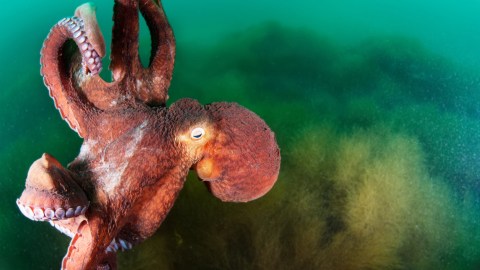Octopus arms can make decisions on their own

Image source: Kondratuk Aleksei/Shutterstock
- Unlike vertebrates, two-thirds of an octopus’ neurons are in its tentacles.
- Tentacles respond to the surrounding environment without help from the head’s brain.
- If something this weird is here on our own Earth, what could be out there in space?
The venue at which Dominic Sivitilli shares his latest research on octopuses is telling enough: an astrobiology conference, AbSciCon2019. At this year’s event, the University of Washington doctoral student describes details that he’s learned on how octopuses gather information, make decisions, and even think.
The behavioral psychologist’s intent? To highlight how the creatures’ decentralized nervous systems are a stunning example of the diversity of forms in which extraterrestrial intelligence may, someday, be encountered.
Indeed, off-planet conscious beings could be so different from us that we might not recognize them as intelligent. If a creature from our own planet can be as strange and alien as octopuses, then we’d better keep our minds open. (It’s not the first time this argument point has been made.)
The decentralized octopus nervous system
Sivitilli’s emphasis is not on, “How intelligent are they?” he says, speaking to UW News. “We are asking, ‘How are they intelligent?'” It’s clear that “Their way of thinking is fundamentally different,” representing “an alternative model for intelligence.” He concludes that the octopus “gives us an understanding as to the diversity of cognition in the world, and perhaps the universe.”
Though no one would claim the finer workings of our own human central nervous system are simple, its rough architecture at least — something we share with other vertebrates — seems pretty straightforward. There’s the brain full of neurons to which receptors throughout our bodies provide information. The neurons process, interpret, store, and develop responses to the information, and the brain sends out signals that control our physical movements.
The cephalopod octopus nervous system is something else entirely. 350 million of its 500 million neurons are in its eight tentacles. At the tentacles’ surface are many thousands of chemical and mechanical receptors. The octopus brain appears to offload interpretation of those inputs, decision-making, and even control of the tentacles to the tentacles, potentially allowing the cephalopods to react to multiple events and circumstances simultaneously. Sivitilli says, “When I do my work, I look at how the arms are acquiring information from the environment, and how they are collectively making decisions about that information.”
A different path to intelligence
The neurons of our central nervous systems are organized around a spinal cord and column, but the cephalopod nervous system coalesced from neurons collected in ganglia distributed throughout the body.
Sivitilli’s advisor neurologist David Gire shares in a conference press release, “One of the big-picture questions we have is just how a distributed nervous system would work, especially when it’s trying to do something complicated, like move through fluid and find food on a complex ocean floor. There are a lot of open questions about how these nodes in the nervous system are connected to each other.”
One of the known mechanisms is a neural ring that allows the tentacle neurons to exchange information directly, bypassing the brain. “So while the brain isn’t quite sure where the arms are in space,” says Sivitilli, “the arms know where each other are, and this allows the arms to coordinate during actions like crawling locomotion.”
His conclusions are based on laboratory research in which he and his colleagues gave octopuses challenges to overcome, in addition to observing them look for food in their tanks. According to Gire, “You’re seeing a lot of little decisions being made by these distributed ganglia, just by watching the arm move, so one of the first things we’re doing is trying to break down what that movement actually looks like, from a computational perspective.”
The story of Gaia
Sivitilli has written movingly in “Across the Evolutionary Divide: the Story of Gaia” about his experience, and relationship, with one particular octopus, a giant Pacific octopus, or Enteroctopus dofleini, whom he named “Gaia.”
He describes the eerie moment they met, and their first impressions of each other. After weeks of diving in the dark, he says, “45 feet below San Juan County Park, my dive team at last methodically encircled a large, camouflaged, breathing mass, as it watched us intently.” After transporting her back to his lab, things didn’t get any less strange:
“Nightfall and finally alone in a quiet, dim lab, I felt my movements being watched. I sat facing my new model, observing her as she continued to fix her gaze upon me. About five feet separated the tips of her opposite arms when she reached them outward — she was young, yet, she seemed so old, reaching out to me from deep evolutionary time.”
Gaia was eventually returned to the sea, leaving Sivitilli, it seems from his writing, with a feeing of profound connection:
“Perceptive, curious, and above all, distant, Gaia manifested everything to me that makes the octopus model so attractive. Two cousins we are, meeting across the evolutionary divide of over 500 million years.“






